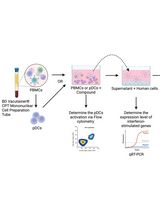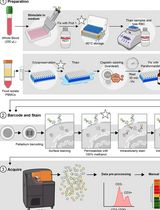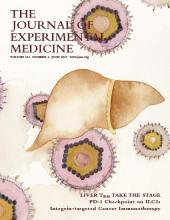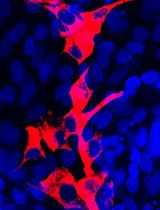- EN - English
- CN - 中文
In vitro Homeostatic Proliferation of Human CD8 T Cells
人CD8 T细胞的体外稳态增殖
发布: 2017年11月20日第7卷第22期 DOI: 10.21769/BioProtoc.2619 浏览次数: 12470
评审: Ivan ZanoniLokesh KalekarAnonymous reviewer(s)

相关实验方案

基于人外周血单个核细胞(PBMCs)和浆细胞样树突细胞(pDCs)的宿主靶向抗病毒药物(HTA)筛选方案
Zhao Xuan Low [...] Pouya Hassandarvish
2025年03月05日 2519 阅读

用于比较人冷冻保存 PBMC 与全血中 JAK/STAT 信号通路的双磷酸化 CyTOF 流程
Ilyssa E. Ramos [...] James M. Cherry
2025年11月20日 1057 阅读
Abstract
Long-lived T-cell–mediated immunity requires persistence of memory T cells in an antigen-free environment while also maintaining a heightened capacity to recall effector functions. Such antigen-independent homeostatic proliferation is mediated in part by the common gamma-chain cytokines IL-7 and IL-15. To further explore the mechanisms governing maintenance of effector functions in long-lived memory T cells during antigen-independent proliferation, human naïve and memory CD8 T cells can be sorted from peripheral blood mononuclear cells (PBMCs), labeled with the proliferation-tracking dye carboxyfluorescein succinimidyl ester (CFSE), and then purified based on their levels of cell division. This allows investigators to assess differences in the desired molecular target in cells that have undergone cytokine-driven proliferation. We provide here a protocol for assessing epigenetic programs in divided and undivided human naïve and memory CD8 T cells following 7 days in culture with IL-7 and IL-15 to illustrate how this approach can shed light on the mechanism(s) that governs the preservation of effector functions during homeostasis of long-lived memory CD8 T cells.
Keywords: Homeostatic proliferation (稳态增殖)Background
A cardinal feature of adaptive immunity is the development of immunological memory against previously encountered pathogens (Plotkin et al., 2013). Memory CD8 T cells play a major role in providing life-long protection against pathogens previously encountered by the host, but in order to provide long-lived protection, T cells must have acquired the ability to persist and maintain effector functions in an antigen-free environment. During this time, memory T cells undergo antigen-independent proliferation in response to IL-7/15 cytokines, albeit to different degrees.
The total pool of memory CD8 T cells is a heterogeneous combination of several different cell subsets that respond differently to homeostatic cytokines. For instance, the highly proliferative central memory (Tcm) subset of CD8 T cells expresses the chemokine receptor CCR7, which enables those cells to access lymphoid tissue. Conversely, the low proliferative effector memory (Tem) subset of CD8 T cells lacks CCR7 expression and has limited access to lymphoid tissue (Sallusto et al., 1999; Masopust et al., 2001). Another recently defined subset of memory T cells, stem-cell memory (Tscm), which were named based on their heightened ability to self-renew and give rise to other memory subsets, exhibits the greatest level of cytokine-driven proliferation, compared to the other subsets (Gattinoni et al., 2011). Although phenotypically and functionally distinct, all of these memory T-cell subsets retain their ability to rapidly recall effector function upon antigen re-exposure. Thus, a common defining feature for the development of the various memory CD8 T-cell subsets is the maintenance of effector functions in the absence of antigen. However, the cell-intrinsic mechanisms that maintain memory-associated effector functions remain poorly understood. Below we describe an in vitro homeostatic proliferation assay that enables us to analyze mechanisms that regulate fate commitment during human memory T-cell homeostasis. We specifically describe loci-specific bisulfite-sequencing DNA-methylation analysis to examine the stability of effector DNA-methylation programs in memory CD8 T-cell subsets over several rounds of cell division (Abdelsamed et al., 2017).
Materials and Reagents
- ART tips 1,000 μl (Thermo Fisher Scientific, Thermo ScientificTM, catalog number: 2079G )
- ART tips 200 μl (Thermo Fisher Scientific, Thermo ScientificTM, catalog number: 2069G )
- ART tips 10 μl (Thermo Fisher Scientific, Thermo ScientificTM, catalog number: 2139-RT )
- 5 ml STRIPETTE (Corning, Costar®, catalog number: 4487 )
- 10 ml STRIPETTE (Corning, Costar®, catalog number: 4488 )
- 25 ml STRIPETTE (Corning, Costar®, catalog number: 4489 )
- 18 G x 1-inch disposable needles (BD, catalog number: 305195 )
- 30 ml BD Luer-Lok syringe (BD, catalog number: 302832 )
- Falcon conical tubes, 50-ml (Corning, Falcon®, catalog number: 352098 )
- Falcon conical tubes, 15-ml (Corning, Falcon®, catalog number: 352057 )
- 96-well cell culture plates, round bottom (Corning, Costar®, catalog number: 3799 )
- Sterile polystyrene Petri dishes 100 x 15 mm (Fisher Scientific, catalog number: FB0875712 )
- Apheresis blood unit
- XL10-Gold Ultracompetent cells (Agilent Technologies, catalog number: 200314 )
- pGEM-T Vector System I (Promega, catalog number: A3600 )
- 1x calcium- and magnesium-free PBS (Lonza, catalog number: 17-516Q )
- Ficoll-Paque PLUS (GE Healthcare, catalog number: 17-1440-02 )
- Trypan blue solution, 0.4% (Sigma-Aldrich, catalog number: T8154 )
- EasySep Human CD8+ T Cell Enrichment Kit (STEMCELL Technologies, catalog number: 19053 )
- Antibodies
CD8 (BioLegend, catalog number: 301033 )
CD45RO (BioLegend, catalog number: 304210 )
CD45RA (BioLegend, catalog number: 304134 )
CCR7 (BD, BD Biosciences, catalog number: 561271 )
CD95 (BioLegend, catalog number: 305622 )
Live dead stain (Tonbo Biosciences, catalog number: 13-0870 ) - CpGenome Direct Prep Bisulfite Modification Kit (Merck, catalog number: 17-10451 )
- Zymoclean Gel DNA Recovery Kit (ZYMO RESEARCH, catalog number: D4002 )
- S.O.C. medium (Thermo Fisher Scientific, InvitrogenTM, catalog number: 15544034 )
- DirectPrep 96 MiniPrep Kit (QIAGEN, catalog number: 27361 )
- Primers for methylation-specific PCR (Purchased from Integrated DNA Technologies) (see Notes for design)
- Heat-inactivated fetal bovine serum (FBS) (GE Healthcare, HycloneTM, catalog number: SH30910.03 )
- RPMI 1640 with L-glutamine (Mediatech, catalog number: 10-040-CM )
- 0.5 M EDTA (Invitrogen, catalog number: 15575-038 )
- Sodium azide (Sigma-Aldrich, catalog number: S2002-25G )
- Carboxyfluorescein succinimidyl ester (CFSE) (Life Technologies, catalog number: C1165 )
- Gentamicin (50 mg/ml) (Thermo Fisher Scientific, GibcoTM, catalog number: 15750060 )
- Penicillin-streptomycin (10,000 U/ml) (Thermo Fisher Scientific, GibcoTM, catalog number: 15140122 )
- Human recombinant IL-7 stock, 250 µg/ml (PeproTech, catalog number: AF-200-07 )
- Human recombinant IL-15 stock, 250 µg/ml (PeproTech, catalog number: AF-200-15 )
- 10x Tris/Boric Acid/EDTA (TBE), nucleic acid electrophoresis buffer (Bio-Rad Laboratories, catalog number: 1610733 )
- Agarose (Hoefer, catalog number: GR140-500 )
- Ethidium bromide 10 mg/ml (Thermo Fisher Scientific, InvitrogenTM, catalog number: 15585011 )
- LB agar miller (Sigma-Aldrich, catalog number: L3027-1KG )
- 2x LB broth (Teknova, catalog number: L8080 )
- Ampicillin (Sigma-Aldrich, catalog number: A9518-5G )
- IPTG (Sigma-Aldrich, catalog number: I6758-10G )
- X-gal (Lambda Biotech)
- JumpStart Taq ReadyMix 2x (Sigma-Aldrich, catalog number: P2893 )
- Heat-inactivated FBS (see Recipes)
- RPMI 1640 with glutamine and 4% FBS (see Recipes)
- Enrichment buffer (see Recipes)
- RPMI 1640 with glutamine, 4% FBS, and 0.02% sodium azide (see Recipes)
- FACS buffer (see Recipes)
- 4 µM CFSE working solution (see Recipes)
- RPMI 1640 with glutamine and 10% FBS (see Recipes)
- Culture medium (see Recipes)
- IL-7 and IL-15 working solutions (see Recipes)
- 1x TBE (see Recipes)
- 2% agarose gel (see Recipes)
- LB agar plates (see Recipes)
Equipment
- Neubauer hemacytometer (Hausser Scientific, catalog number: 3200 )
- P1000 (Gilson, catalog number: F123602 )
- P200 (Gilson, catalog number: F123601 )
- P10 (Gilson, catalog number: F144802 )
- Water bath
- 37 °C shaker
- 37 °C incubator
- Sorval Legend XTR centrifuge (Thermo Fisher Scientific, Thermo ScientificTM, model: SorvalTM LegendTM XTR , catalog number: 75004520)
- EasySep STEMCELL Technologies 15-ml and 50-ml magnets
- Tissue culture incubator
- Biosafety cabinet
- Horizontal gel electrophoresis unit (Hoefer, model: SUBHT )
- Vacuum manifold
- Nikon Eclipse TS100 microscope (Nikon Instruments, model: Eclipse TS100 )
- Sony Biotechnology SY3200 sorter (Synergy) (Sony Biotechnology, model: SY3200 )
- Autoclave (Getinge, model: 133LS )
Software
- FlowJo Software (Version 9.7.6)
- QUMA Software (http://quma.cdb.riken.jp/)
Procedure
文章信息
版权信息
© 2017 The Authors; exclusive licensee Bio-protocol LLC.
如何引用
Abdelsamed, H. A., Zebley, C. C. and Youngblood, B. (2017). In vitro Homeostatic Proliferation of Human CD8 T Cells. Bio-protocol 7(22): e2619. DOI: 10.21769/BioProtoc.2619.
分类
免疫学 > 免疫细胞分化 > T 细胞
免疫学 > 免疫细胞功能 > 细胞因子
细胞生物学 > 细胞分离和培养 > 细胞分化
您对这篇实验方法有问题吗?
在此处发布您的问题,我们将邀请本文作者来回答。同时,我们会将您的问题发布到Bio-protocol Exchange,以便寻求社区成员的帮助。
提问指南
+ 问题描述
写下详细的问题描述,包括所有有助于他人回答您问题的信息(例如实验过程、条件和相关图像等)。
Share
Bluesky
X
Copy link









